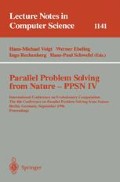Abstract
We present a first attempt in applying a genetic algorithm for checking the correctness of communication protocols (expressed as a pair of communicating FSMs). The GA measures the fitness of a given string by making use of a protocol simulator. Every string in the population is a trace of the execution of the protocol. The simulator evaluates the trace by running it, provoking changes and messages exchanges in the states of every FSM. The fitness of a string (trace) is high if the string detects a deadlock or if useless states or transitions are encountered. We are interested in testing the suitness of the GA search in such a domain. We have tested this genetic validation on a hand-made protocol and on the Transmission Control Protocol (TCP).
Preview
Unable to display preview. Download preview PDF.
References
Alba, E., Aldana, J. F. and Troya, J. M., Genetic Algorithms as Heuristics for Optimising ANN Design. R.F. Albrecht, C.R. Reeves and N.C. Steele (eds), Artificial Neural Nets and Genetic Algorithms, Innsbruck. Springer-Verlag, pp 683–690. (1993)
Alba, E., Aldana, J. F. and Troya, J. M., Load Balancing and Query Optimisation in Dataflow Parallel Evaluation of Datalog Programs. Lionel M. Ni (ed), Proceedings of the International Conference on Parallel and Distributed Systems, Taiwan. IEEE Computer Society Press, pp 682–688. (1994)
Beasley, D., Bull, D. R. and Martin, R. R., An Overview of Genetic Algorithms: Part 1 (Fundamentals) and Part 2 (Research Topics). University Computing, pp 58–69 15(2) and 15(4) pp 170–181. (1993)
Díaz, M. and Troya, J.M., A Parlog Based Real-Time Distributed Environment. Future Generation Computer Systems 9, pp 201–218, North-Holland. (1993)
Goldberg, D. E., Genetic Algorithms, in Search, Optimization and Machine Learning. Addison-Wesley. (1989)
Fogel, L. J., Owens, A. J. and Walsh, M. J., Artificial Intelligence Through Simulated Evolution. New York, John Wiley. (1966)
ISO, LOTOS-A Formal Description Technique Based on the Temporal Ordering of Observational Behaviour. ISO IS 8807. (1989)
ISO, ESTELLE-A Formal Description Technique Based on State Transition Model. ISO 9074. (1989)
Author information
Authors and Affiliations
Editor information
Rights and permissions
Copyright information
© 1996 Springer-Verlag Berlin Heidelberg
About this paper
Cite this paper
Alba, E., Troya, J.M. (1996). Genetic algorithms for protocol validation. In: Voigt, HM., Ebeling, W., Rechenberg, I., Schwefel, HP. (eds) Parallel Problem Solving from Nature — PPSN IV. PPSN 1996. Lecture Notes in Computer Science, vol 1141. Springer, Berlin, Heidelberg. https://doi.org/10.1007/3-540-61723-X_1050
Download citation
DOI: https://doi.org/10.1007/3-540-61723-X_1050
Published:
Publisher Name: Springer, Berlin, Heidelberg
Print ISBN: 978-3-540-61723-5
Online ISBN: 978-3-540-70668-7
eBook Packages: Springer Book Archive

